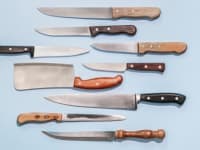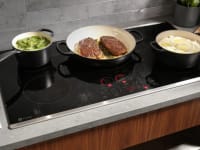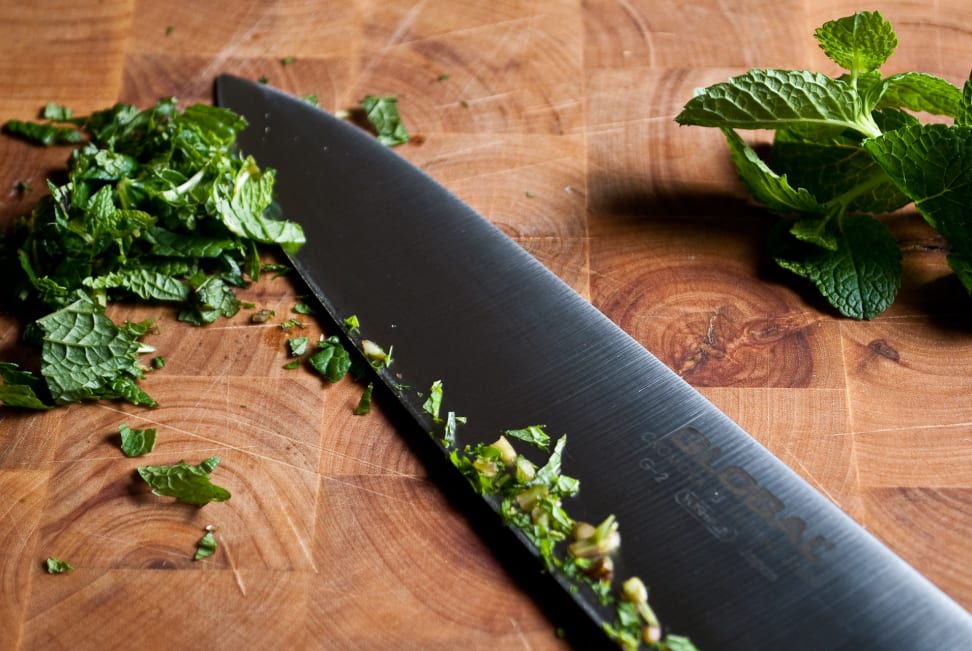 Credit:
Flickr user "thomaaas"
Credit:
Flickr user "thomaaas"
Products are chosen independently by our editors. Purchases made through our links may earn us a commission.
I have a confession to make.
Despite my outsized love for food and cooking, I passed the majority of my adult life without ever using a chef's knife. But, after nearly losing several fingers while cutting up a butternut squash, I decided enough was enough. I set out to purchase my first real kitchen blade.
A simple "best kitchen knife" Google search turned into an Alice in Wonderland–esque trip down the rabbit hole. After months of scouring reviews, articles, and forum posts, I emerged bleary-eyed, haunted, and arguably more confused then when I started. But I also found the right knife for me, and came away with a few nuggets of wisdom I can pass on to you.
Most importantly, I learned that there is no such thing as "the best chef's knife." There are plenty of excellent knives, but the best knife is the one you feel most comfortable using. To that end, my top tip is that you should ideally find a way to handle a knife you are thinking about buying, or purchase from an online retailer with a good return policy.
Beyond that, here's what you need to know.
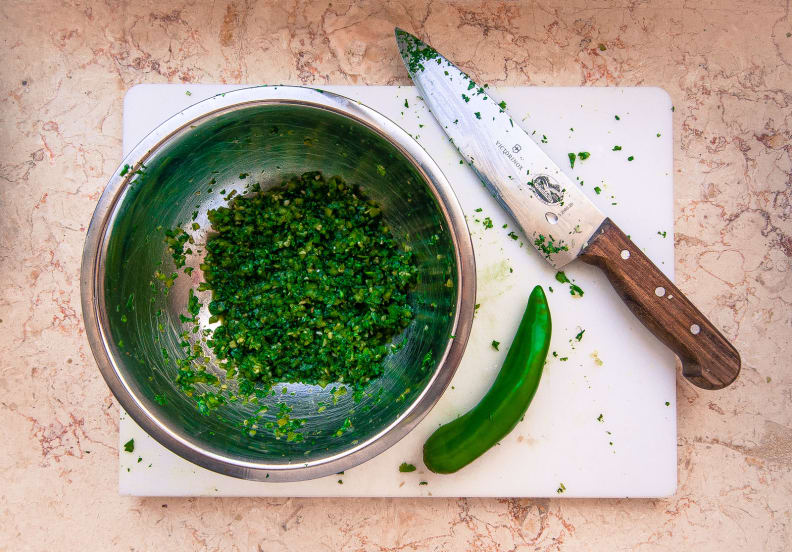
If you spend any time prepping food, a good knife is an absolute necessity.
1. Forget about that tang
{{amazon name="Global G-2 - 8 inch, 20cm Chef's Knife", asin="B00005OL44", align="right"}} Not to be confused with the delightfully sugary space drink, the tang of a knife is the part of the blade that extends into the handle. It’s commonly believed that a full tang—one that extends to the end of the handle—is the hallmark of a good knife.
While it’s true that a full tang can improve stability, control, and durability, it’s unlikely to have serious impact on the blade's durability—unless you plan on cutting two-by-fours with your chef's knife. Furthermore, with the rise of Japanese-style chef knives and improved construction methods, a full tang is less important than it used to be.
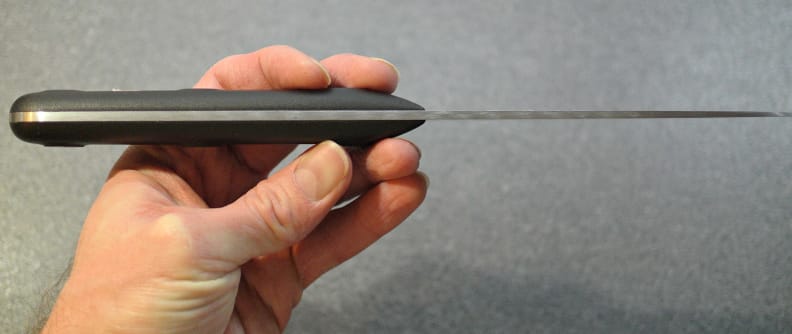
A full tang extends from the front of the handle to the back.
2. Forget about the bolster, too
{{amazon name="Victorinox Fibrox 8-Inch Chef's Knife 40520, 47520, 45520, 5.2063.20", asin="B000638D32", align="right"}} A knife's bolster is the widened section of metal where the blade meets the handle. A bolster can protect your hands from the end of the blade, and can add stability—especially in heavier knives.
Like a full tang, a full bolster was original considered a certain sign of quality in a knife. Most Western knives still feature them, but bolsters are rare in Japanese or hybrid blades, and in today's market their presence is largely a matter of personal preference.
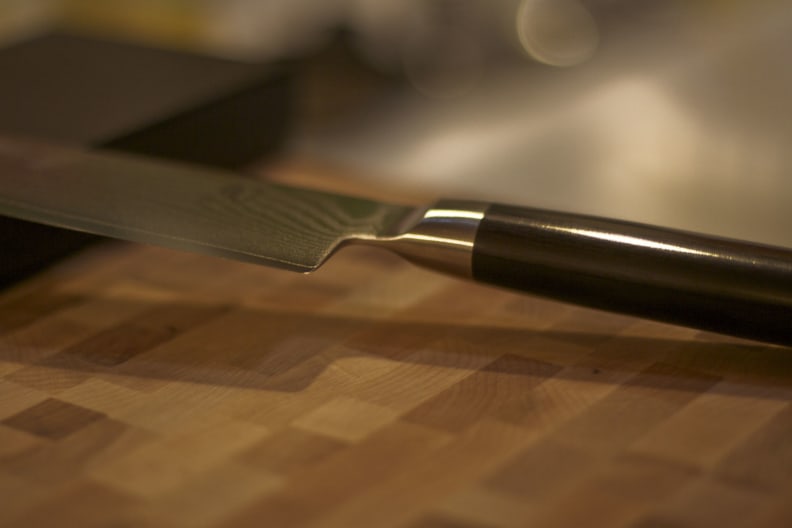
The bolster is the term for the thick section where the blade meets the knife handle.
3. Handle with care
Considering it’s the part of the knife you'll be in contact with most often (we hope, anyway) handle material and size can make a big difference.
{{amazon name="Shun Premier Chef's Knife, 8-Inch", asin="B003B66YKA", align="right"}} Depending on cost and style, a knife's handle will be constructed from either plastic, wood, or metal. Plastic is often found on cheaper knives, but what it lacks in finesse it makes up for in durability. Wooden handles are easier on the hand, but depending on quality can become worn and/or riddled with bacteria.
Size can also play major role in your overall knife-handling experience. Unless you're working in a professional kitchen, you should probably stick with a knife no longer than eight inches. Chef knives can be as long as 12 inches, but those are designed for working chefs who need to prep large quantities of food in a small amount of time.
Be sure to pick a knife with a handle that suits your hand size. If you have small hands, a thick handle will become painful after a while. Conversely, if you have large hands and work with a small handle, getting a stable grip will be challenging. That increases the risk of an accident.
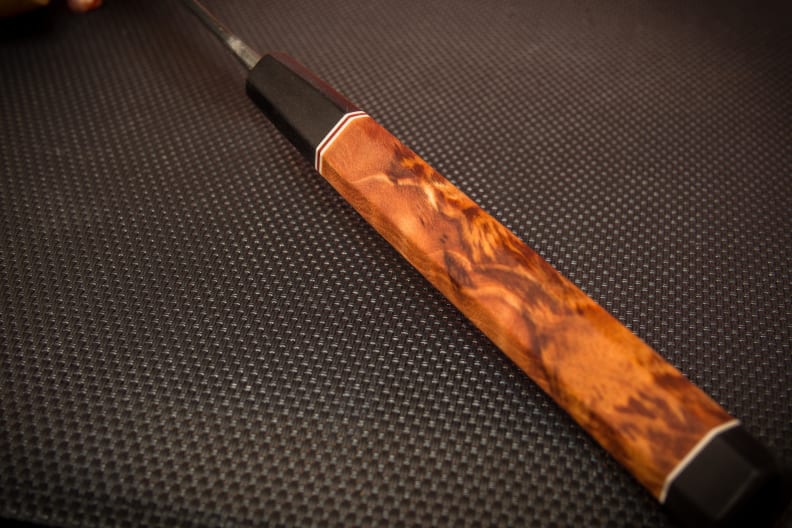
A high-quality handle makes all the difference.
4. Don't get hung up on construction
It's a common misconception that a forged blade is inherently better than a stamped blade. This may have been true once upon a time, but with modern manufacturing techniques it's no longer that simple. Once again, we're largely looking at a matter of preference.
{{amazon name="Yoshihiro VG-10 Damascus Santoku Multipurpose Japanese Chef Knife 7" (Western Style Mahogany Handle)", asin="B00D6DVTO4", align="right"}} Forged blades begin as a lump of metal. The metal is heated and hammered into shape, then ground and sharpened. Forged blades also have an integrated bolster. Stamped blades are laser-cut from a sheet of metal, and the bolster is often welded to the blade.
Forged blades feel heavier in the hand and are easier to sharpen, but they lose their edge pretty fast. Stamped blades are lighter and sharper and hold their edge longer. The tradeoff is they're much harder to sharpen at home.
A good rule of thumb is that all bad knives are stamped, but not all stamped knives are bad.
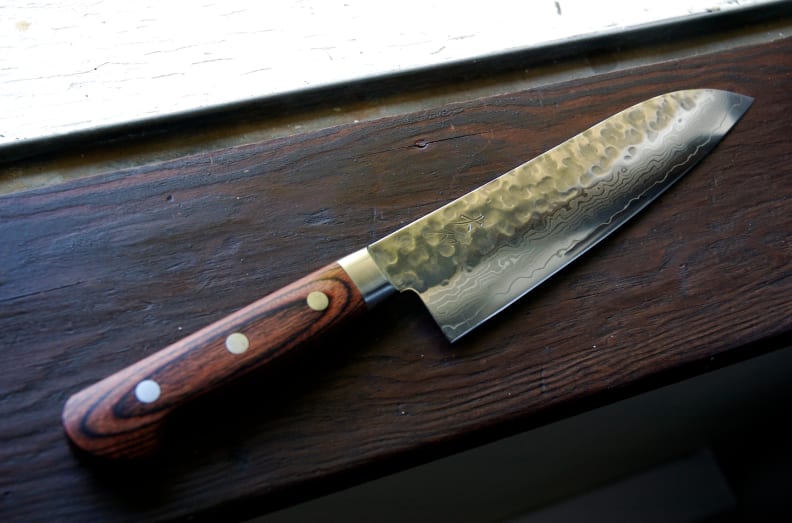
While they have their advantages, forged blades aren't inherently better than stamped blades.
5. Know your metals
Your choice between a stainless or carbon steel blade will most likely come down to how much you're willing spend, and whether you value convenience over durability.
{{amazon name="Shun DM0718 Classic 7-Inch Santoku Hollow Ground Knife", asin="B0000Y7KPO", align="right"}} While neither material is inherently better than the other, many experienced chefs swear by high-carbon blades since they tend to be sharper, hold their edge longer, and are easier to sharpen when they finally dull. However, they require careful maintenance to prevent rusting and degradation.
If you want the best of both worlds, you can look into purchasing a clad knife. These knives are comprised of a sheet of high-carbon steel (which serves as the cutting edge) sandwiched between two stainless-steel exterior sheets. While a little more expensive than single metal blades, clad knives combine the finely honed edge of high-carbon with the rust-resistant properties of stainless steel.
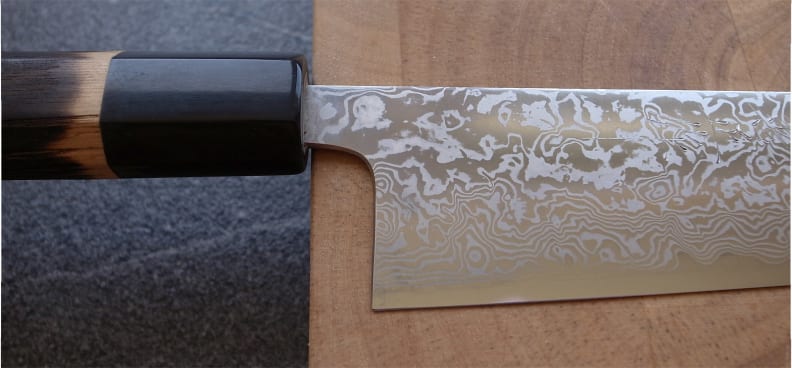
Cladding offers the best of both worlds
6. Pick the style that's right for you
There are a number of styles and types of high-utility knives, but if you're just starting out, you should limit your choices to either a Western, Santoku, or Hybrid (or Gyutou) chef's knife.
{{amazon name="Ergo Chef Crimson Series Chef Knife, 8-Inch", asin="B008M5U1C2", align="right"}} Western chef's knifes are wedge-shaped, heavier, and sturdier than the alternatives, and often have a pronounced bolster. They'll make short work of most vegetables and bone-in meat, but are less suitable for delicate work.
Santoku knives are Japanese in origin and feature a less pronounced curve than their Western siblings. This makes them harder to use for rocking cuts, like you'd use to dice an onion. Lighter, shorter, and thinner than their Western counterparts, these blades are well-suited to fish, vegetables, and boneless meat. Santoku knives are arguably more useful for experienced chefs and should ideally be used in tandem with a Western chef's knife.
Hybrid knives attempt to bridge the gap between Western and Santoku style knives. To that end, they're fairly light, sharp, and versatile. They have more of a curved edge than the Santoku style.
{{ photo_gallery name="Style" }}
As you can see, picking the right knife involves making a lot of small yet important decisions. However, provided you do your homework, set aside a reasonable amount of cash, and weigh all the options, you should end up with a sturdy blade that will serve you well for years to come.
Related Video
{{brightcove '4434671667001'}}

